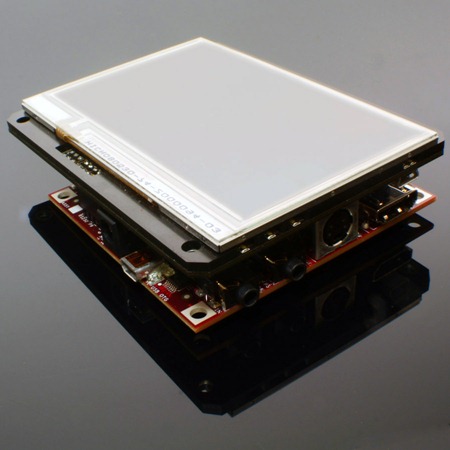Matt and I lined up one of almost every major modular gadget platform that he, Chris, Mike, and I have made over the past 2 years in one spot on the table. We called it “The evolution of Liquidware’s modular gadgets” and in tribute, found an old copy of Stephen Hawking’s A Brief History of Time.


First there was the Arduino and the TouchShield Stealth. This combination let anyone with an Atmel 168-powered Arduino Diecimila make small, handheld, portable, self-contained gadgets.

Then came the TouchShield Slide, for programmers with more demanding applications who wanted larger screen real estate, and a more accurate touchscreen to pair with the more powerful Arduino Duemilanove. The TouchShield Slide was featured on TV in NYC, used by celebrities, hacked by NASA, used for industrial design, and for rapid prototyping by the Department of Defense (no joke, they’re probably reading this right now and shaking their heads tsk tsk). The TouchShield Slide let the Arduino run Mario, and it has its own open source operating system, Pyxis, and a lightweight port of a small MacOS by Mark.

Then there was what Eric von Hippel would call “architectural innovation”, which is where the same modules are used over and over, but the architecture and the substrate changes and morphs as the modules are reconfigured into new setups.
This is the Arduino Gameboy Gamepack with an Arduino Duemilanove, Lithium Backpack, Doublewide Extendershield, Touchshield Slide, and Inputshield.

Here’s a picture of the Arduino Mega and the Mega Backpack with a TouchShield Slide:

Then there was the TripleWide Extender, which I used for the open source calculator project:

And now… hot on the tails of Apple’s announcement of the newest iPhone v4, Justin, Chris, Mike, Paul, and I present the new Open Source Hardware, modular BeagleTouch:

The BeagleTouch is a open source hardware modular screen, which snaps onto the BeagleBoard, and lets someone build and prototype handheld Linux gadgets.
3 comments:
sexy pictures! i really like that last one :-)
hey it's on the front page of make blog too...
Does it work with the revB Beagle boards? Or does it need a rec C board?
If it only needs USB, it seems to me that rev B should be fine. If it needs the LCD headers, then clearly a rev C board would be needed.
Any thoughts?
Post a Comment